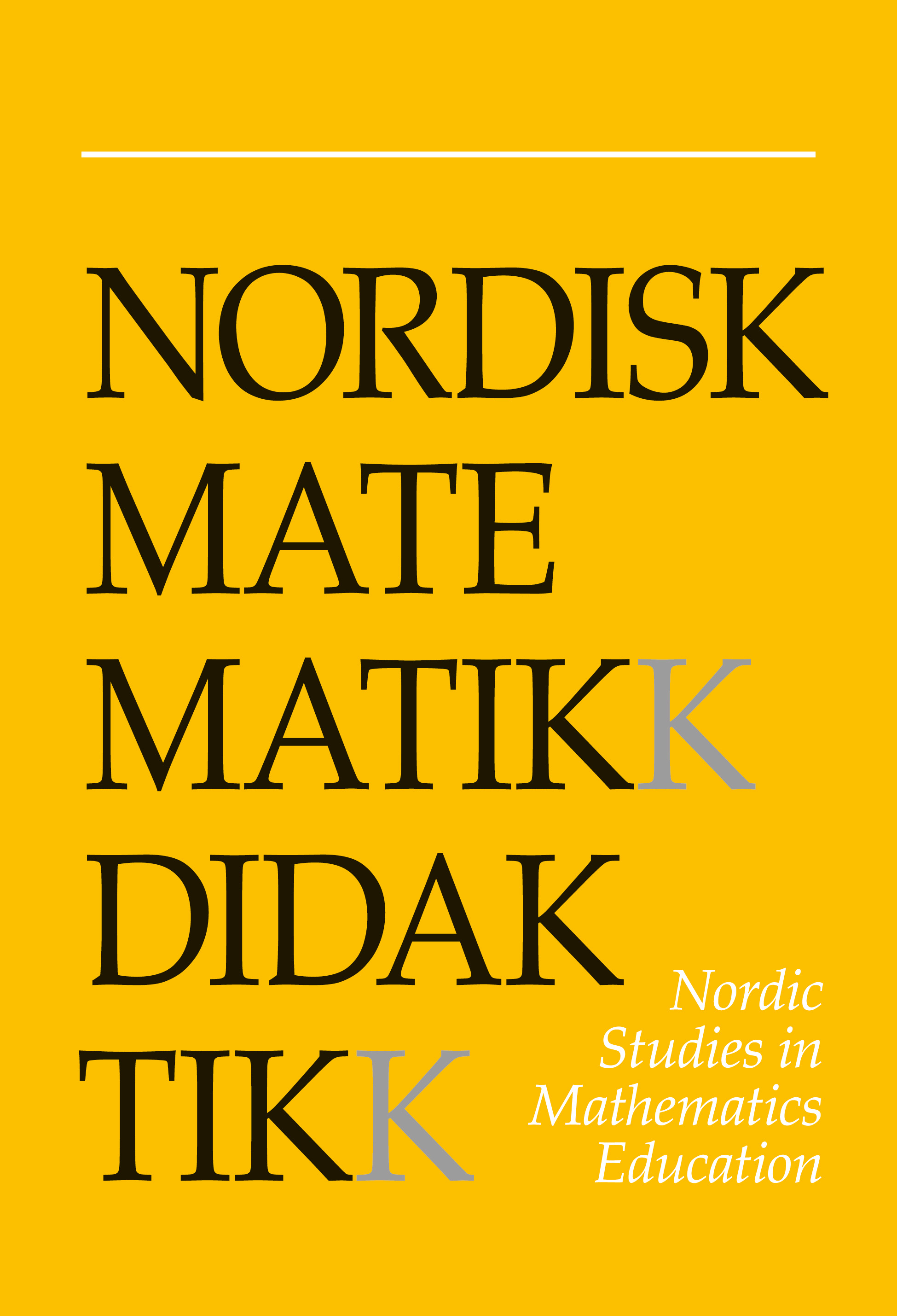A model for the role of the physical environment in mathematics education
DOI:
https://doi.org/10.7146/nomad.v23i1.148948Abstract
In this paper, we develop an analytical tool for the role of the physical environment in mathematics education. We do this by extending the didactical triangle with the physical environment as a fourth actor and test it in a review of literature concerning the physical environment and mathematics education. We find that one role played by the physical environment, in relation to mathematical content, is to portray the content in focus, such as geometry and scale. When focusing on teachers, students, and the interaction between them, the role of the physical environment appears to be a precondition, either positive (enabling) or negative (hindering). Many of the findings are valid for education in general as well, such as the importance of building status.
References
Balacheff, N. (2000). A modelling challenge: untangling learner knowledge. In D. Michel (Ed.), L ́apprentissage, une approche transdisciplinaire (JIOSC 2000) (pp. 7-16). Orsay: Institut des Sciences Cognitives et de la Communication.
Barad, K. (2003). Posthumanist performativity: toward an understanding of how matter comes to matter. Signs, 28 (3), 801-831. https://doi.org/10.1086/345321
Barnitt, H. (2003). Lighting for the future. Building services journal: the magazine for the CIBSE, 25 (1), 38-39.
Barrett, P., Zhang, Y., Moffat, J. & Kobbacy, K. (2013). A holistic, multi-level analysis identifying the impact of classroom design on pupils' learning. Building and Environment, 59, 678-689. https://doi.org/10.1016/j.buildenv.2012.09.016
Braun, V. & Clarke, V. (2006). Using thematic analysis in psychology. Qualitative research in psychology, 3 (2), 77-101. https://doi.org/10.1191/1478088706qp063oa
Earthman, G. I. (2004). Prioritization of 31 criteria for school building adequacy. Baltimore: American Civil Liberties Union Foundation of Maryland.
Enmarker, I. & Boman, E. (2004). Noise annoyance responses of middle school pupils and teachers. Journal of Environmental Psychology, 24 (4), 527-536. https://doi.org/10.1016/j.jenvp.2004.09.005
Gadanidis, G. & Geiger, V. (2010). A social perspective on technology- enhanced mathematical learning: from collaboration to performance. ZDM, 42 (1), 91-104. https://doi.org/10.1007/s11858-009-0213-5
Gomez, P. (2002). Theory and practice in pre-service mathematics teacher education from a social perspective. In P. Valero & O. Skovsmose (Eds.), Proceedings of the 3rd International MES Conference (pp. 282-291). Copenhagen: Centre for Research in Learning Mathematics.
Gump, P.V. (1978). School environments. In I. Altman & J. F. Wohlwill (Eds.), Children and the Environment (pp. 131-74). New York: Plenum Press. https://doi.org/10.1007/978-1-4684-3405-7_5
Hiebert, J. (2003). What research says about the NCTM Standards. In J. Kilpatrick, W. G. Martin & D. Schifter (Eds.), A research companion to Principles and Standards for School Mathematics (pp. 5-23). Reston: National Council of Teachers of Mathematics.
Hunting, R. P. & Lamon, S. J. (1995). A re-examination of the role of instructional materials in mathematics education. Nordic Studies in Mathematics Education, 3 (3), 45-64.
Hygge, S. & Knez, I. (2001). Effects of noise, heat and indoor lighting on cognitive performance and self-reported affect. Journal of Environmental Psychology, 21 (3), 291-299. https://doi.org/10.1006/jevp.2001.0222
Ising, H. & Kruppa, B. (2004). Health effects caused by noise: evidence in the literature from the past 25 years. Noise and Health, 6 (22), 5-13.
Johnston, S. (2012). Maths in the Board Room. Australian Mathematics Teacher, 68 (4), 12-16. https://doi.org/10.12968/prtu.2012.1.12.38
Klatte, M., Hellbrück, J., Seidel, J. & Leistner, P. (2010). Effects of classroom acoustics on performance and well-being in elementary school children: a field study. Environment and Behavior, 42 (5), 659-692. https://doi.org/10.1177/0013916509336813
Liljedahl, P. (2016). Building thinking classrooms: conditions for problem- solving. In P. Felmer, E. Pehkonen & J. Kilpatrick (Eds.), Posing and solving mathematical problems (pp. 361-386). Cham: Springer. https://doi.org/10.1007/978-3-319-28023-3_21
Lindgren, J. (2010). Spaces of social inclusion and exclusion - a spatial approach to education restructuring. Education Inquiry, 1 (2), 69-89. https://doi.org/10.3402/edui.v1i2.21934
Olive, J., Makar, K., Hoyos, V., Kor, L. K., Kosheleva, O. & Sträßer, R. (2010). Mathematical knowledge and practices resulting from access to digital technologies. In C. Hoyles & J. B. Lagrange (Eds.), Mathematics education and technology - rethinking the terrain (pp. 133-177). New York: Springer. https://doi.org/10.1007/978-1-4419-0146-0_8
Rezat, S. & Sträßer, R. (2012). From the didactical triangle to the socio- didactical tetrahedron: artifacts as fundamental constituents of the didactical situation. ZDM, 44 (5), 641-651. https://doi.org/10.1007/s11858-012-0448-4
Scarlatos, L. L. (2006) Tangible math. International Journal of Interactive Technology and Smart Education, 3 (4), 293-309. https://doi.org/10.1108/17415650680000069
Schoenfeld, A. H. (2012). Problematizing the didactical triangle. ZDM, 44 (5), 587-599. https://doi.org/10.1007/s11858-012-0395-0
Soja, E. (2009). The city and spatial justice. Justice Spatiale/Spatial Justice, 1. https://doi.org/10.5749/minnesota/9780816666676.003.0001
Soygenis, S. & Erktin, E. (2010). Juxtaposition of architecture and mathematics for elementary school students. International Journal of Technology and Design Education, 20 (4), 403-415. https://doi.org/10.1007/s10798-009-9100-1
Straesser, R. (2007). Didactics of mathematics: more than mathematics and school!. ZDM, 39 (1-2), 165-171. https://doi.org/10.1007/s11858-006-0016-x
Szczepanski, A. & Andersson, P. (2015). Perspectives on place: 15 professors conceptions of the importance of the place for learning and teaching outdoors [Perspektiv på plats: 15 professorers uppfattningar av platsens betydelse för lärande och undervisning utomhus]. Pedagogisk forskning i Sverige, 20, 127-149.
Tanner, C. K. (2009). Effects of school design on student outcomes. Journal of Educational Administration, 47 (3), 381-399. https://doi.org/10.1108/09578230910955809
Tuan, Y. F. (1975). Place: an experiential perspective. Geographical Review, 65, 151-165. https://doi.org/10.2307/213970
Tuan, Y. F. (1979). Space and place: humanistic perspective. In S. Gale & G. Olsson (Eds.), Philosophy in geography (pp. 387-427). Dordrecht: Springer. https://doi.org/10.1007/978-94-009-9394-5_19
Uline, C. & Tschannen-Moran, M. (2008). The walls speak: the interplay of quality facilities, school climate, and student achievement. Journal of Educational Administration, 46 (1), 55-73. https://doi.org/10.1108/09578230810849817
Uline, C., Tschannen-Moran, M. & Wolsey, T. D. (2009). The walls still speak: the stories occupants tell. Journal of Educational Administration, 47 (3), 400-426. https://doi.org/10.1108/09578230910955818
Uline, C., Wolsey, T. D., Tschannen-Moran, M. & Lin, C. D. (2010). Improving the physical and social environment of school: a question of equity. Journal of school leadership, 20(5),597-632. https://doi.org/10.1177/105268461002000504
Downloads
Published
How to Cite
Issue
Section
License

This work is licensed under a Creative Commons Attribution-NonCommercial-ShareAlike 4.0 International License.



